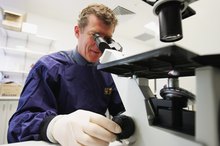Symptoms From Drinking Coliform Bacteria in Water
Coliform bacteria are members of the enterobacteria family, a group of pathogens that commonly cause gastrointestinal ailments. Coliform infections usually result from ingesting contaminated food or water. Major coliform bacteria include shigella, which causes dysentery; certain trains of Escherichia coli (referred to as E. coli), which can cause urinary tract infections and diarrhea; and salmonella, which causes diarrhea and vomiting.
Diarrhea
The most common result of a coliform bacterial infection is diarrhea. The bacteria shigella can cause dysentery, characterized by copious bloody diarrhea. The closely related E. coli bacteria are generally neutral, or even beneficial, but a few strains are pathogenic, and can cause diarrhea. Although most cases of E. coli infection result in mild, food-poisoning-like symptoms, E. coli can give rise to hemolytic uremic syndrome, a disease similar to dysentery, and potentially life-threatening. Both shigella and pathogenic E. coli can be contracted from drinking contaminated water, or from eating food that either contains a large amount of contaminated water, or has been washed in contaminated water. Most cases of diarrheal shigella and E. coli resolve on their own after a short period, so antibiotics reserved for severe cases.
- The most common result of a coliform bacterial infection is diarrhea.
- Both shigella and pathogenic E. coli can be contracted from drinking contaminated water, or from eating food that either contains a large amount of contaminated water, or has been washed in contaminated water.
Gastroenteritis
List of Common Bacteria and Guardia Found in Creeks & Streams
Learn More
Vomiting, abdominal pain, fever, and diarrhea are all symptoms of gastroenteritis — commonly referred to as “food poisoning” — and can be caused by either eating or drinking coliform bacteria, especially strains of salmonella. Meat or poultry products are common causes of salmonella-induced food poisoning in the United States, but salmonella can also be contracted from contaminated water — a major problem in other parts of the world. As gastroenteritis generally lasts just two to three days, antibiotics are of little use, but may be prescribed if complications result, or if the patient is already ill or his immune system is otherwise compromised.
Typhoid Fever
Although rare in developed countries, typhoid fever caused by the bacteria salmonella typhi remains a serious problem in the developing world. Typhoid fever is a systemic disease characterized by flu-like symptoms: headaches, abdominal tenderness, dry coughing, loss of appetite, and fever. Typhoid sufferers often exhibit a rash of raised red spots, generally on the front of the chest, which fade after three to four days. If left untreated, typhoid fever is fatal in approximately 20% of cases. Like the other diseases caused by coliform bacteria, typhoid fever is contracted from eating or drinking contaminated food or water. A vaccine against the disease provides a high level of protection, and lasts for about three years; it is encouraged for anyone traveling to developing countries with high levels of typhoid fever, particularly if they plan to travel in areas with poor sanitation.
- Although rare in developed countries, typhoid fever caused by the bacteria salmonella typhi remains a serious problem in the developing world.
- Typhoid fever is a systemic disease characterized by flu-like symptoms: headaches, abdominal tenderness, dry coughing, loss of appetite, and fever.
Urinary Tract Infections
Diseases Caused by Chickens
Learn More
Urinary tract infections (UTIs) can be caused by pathogenic strains of E. coli and of klebselia, a similar coliform bacteria. As with the diarrheal diseases, UTIs can be caused by drinking contaminated water, although are more often caused by direct contact with the bacteria. UTIs primarily affect women, and are especially common in pregnant women, due to hormonal changes and physical pressure on the urinary tract. UTIs are generally treatable with antibiotics, although the number of antibiotic-resistant strains of E. coli is growing.
- Urinary tract infections (UTIs) can be caused by pathogenic strains of E. coli and of klebselia, a similar coliform bacteria.
Related Articles
References
- “Medical Microbiology”: edited by David Greenwood, Richard Slack, John Peutherer, and Mike Barer; 2007
- “Kelley's Textbook of Internal Medicine”: H. David Humes; 2000
- Centers for Disease Control and Prevention. Typhoid Fever and Paratyphoid Fever. Updated August 22, 2018.
- Bush L. Typhoid Fever. Merck Manual Consumer Version. Updated May 2018.
- Centers for Disease Control and Prevention. Typhoid Fever and Paratyphoid Fever. Updated August 22, 2018.
- UK National Health Service. Complications: Typhoid Fever. Updated June 18, 2018.
- Bush L. Typhoid Fever. Merck Manual Consumer Version. Updated May 2018.
- Marineli F, Tsoucalas G, Karamanou M, Androutsos G. Mary Mallon (1869-1938) and the history of typhoid fever. Ann Gastroenterol. 2013;26(2):132-134.
Writer Bio
Elisabeth Kilmaren has been writing since 2007. As a microbiologist, she has published in "PLOS Pathogens" and the "Journal of Virology." Kilmaren has a dual Bachelor of Arts in biology and chemistry, and is currently working toward her Doctor of Philosophy in microbiology. She graduated from Scripps College in 2006.








